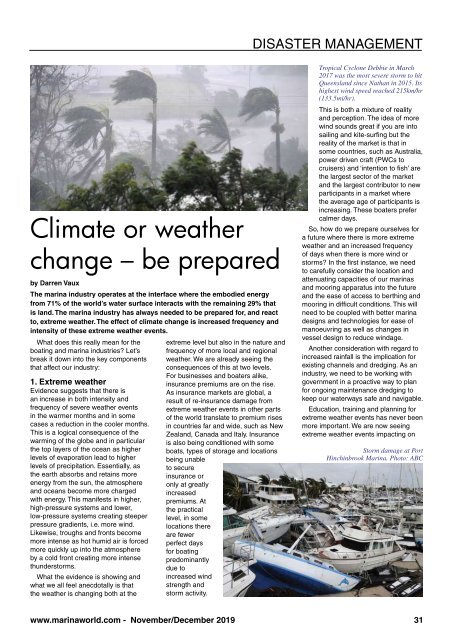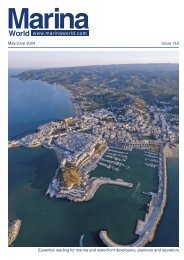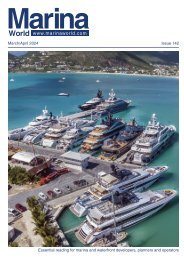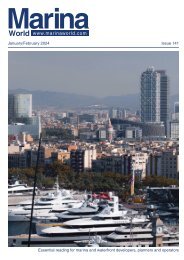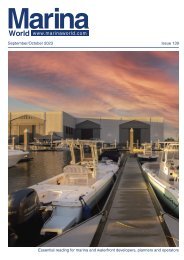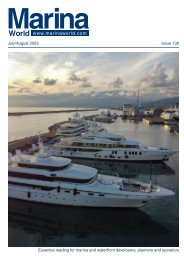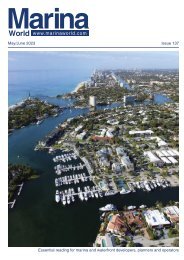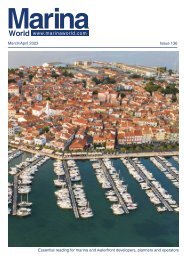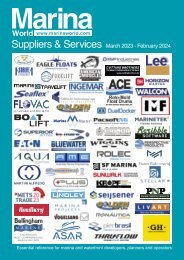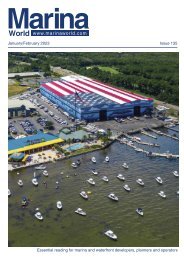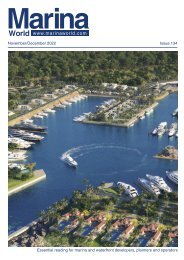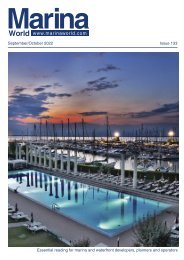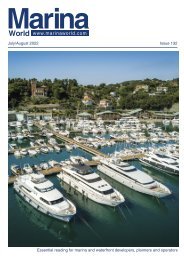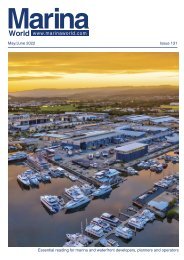November December 2019 Marina World
The magazine for the marina industry
The magazine for the marina industry
Create successful ePaper yourself
Turn your PDF publications into a flip-book with our unique Google optimized e-Paper software.
DISASTER MANAGEMENT<br />
Climate or weather<br />
change – be prepared<br />
by Darren Vaux<br />
The marina industry operates at the interface where the embodied energy<br />
from 71% of the world’s water surface interacts with the remaining 29% that<br />
is land. The marina industry has always needed to be prepared for, and react<br />
to, extreme weather. The effect of climate change is increased frequency and<br />
intensity of these extreme weather events.<br />
What does this really mean for the<br />
boating and marina industries? Let’s<br />
break it down into the key components<br />
that affect our industry:<br />
1. Extreme weather<br />
Evidence suggests that there is<br />
an increase in both intensity and<br />
frequency of severe weather events<br />
in the warmer months and in some<br />
cases a reduction in the cooler months.<br />
This is a logical consequence of the<br />
warming of the globe and in particular<br />
the top layers of the ocean as higher<br />
levels of evaporation lead to higher<br />
levels of precipitation. Essentially, as<br />
the earth absorbs and retains more<br />
energy from the sun, the atmosphere<br />
and oceans become more charged<br />
with energy. This manifests in higher,<br />
high-pressure systems and lower,<br />
low-pressure systems creating steeper<br />
pressure gradients, i.e. more wind.<br />
Likewise, troughs and fronts become<br />
more intense as hot humid air is forced<br />
more quickly up into the atmosphere<br />
by a cold front creating more intense<br />
thunderstorms.<br />
What the evidence is showing and<br />
what we all feel anecdotally is that<br />
the weather is changing both at the<br />
extreme level but also in the nature and<br />
frequency of more local and regional<br />
weather. We are already seeing the<br />
consequences of this at two levels.<br />
For businesses and boaters alike,<br />
insurance premiums are on the rise.<br />
As insurance markets are global, a<br />
result of re-insurance damage from<br />
extreme weather events in other parts<br />
of the world translate to premium rises<br />
in countries far and wide, such as New<br />
Zealand, Canada and Italy. Insurance<br />
is also being conditioned with some<br />
boats, types of storage and locations<br />
being unable<br />
to secure<br />
insurance or<br />
only at greatly<br />
increased<br />
premiums. At<br />
the practical<br />
level, in some<br />
locations there<br />
are fewer<br />
perfect days<br />
for boating<br />
predominantly<br />
due to<br />
increased wind<br />
strength and<br />
storm activity.<br />
Tropical Cyclone Debbie in March<br />
2017 was the most severe storm to hit<br />
Queensland since Nathan in 2015. Its<br />
highest wind speed reached 215km/hr<br />
(133.5mi/hr).<br />
This is both a mixture of reality<br />
and perception. The idea of more<br />
wind sounds great if you are into<br />
sailing and kite-surfing but the<br />
reality of the market is that in<br />
some countries, such as Australia,<br />
power driven craft (PWCs to<br />
cruisers) and ‘intention to fish’ are<br />
the largest sector of the market<br />
and the largest contributor to new<br />
participants in a market where<br />
the average age of participants is<br />
increasing. These boaters prefer<br />
calmer days.<br />
So, how do we prepare ourselves for<br />
a future where there is more extreme<br />
weather and an increased frequency<br />
of days when there is more wind or<br />
storms? In the first instance, we need<br />
to carefully consider the location and<br />
attenuating capacities of our marinas<br />
and mooring apparatus into the future<br />
and the ease of access to berthing and<br />
mooring in difficult conditions. This will<br />
need to be coupled with better marina<br />
designs and technologies for ease of<br />
manoeuvring as well as changes in<br />
vessel design to reduce windage.<br />
Another consideration with regard to<br />
increased rainfall is the implication for<br />
existing channels and dredging. As an<br />
industry, we need to be working with<br />
government in a proactive way to plan<br />
for ongoing maintenance dredging to<br />
keep our waterways safe and navigable.<br />
Education, training and planning for<br />
extreme weather events has never been<br />
more important. We are now seeing<br />
extreme weather events impacting on<br />
Storm damage at Port<br />
Hinchinbrook <strong>Marina</strong>. Photo: ABC<br />
www.marinaworld.com - <strong>November</strong>/<strong>December</strong> <strong>2019</strong> 31


